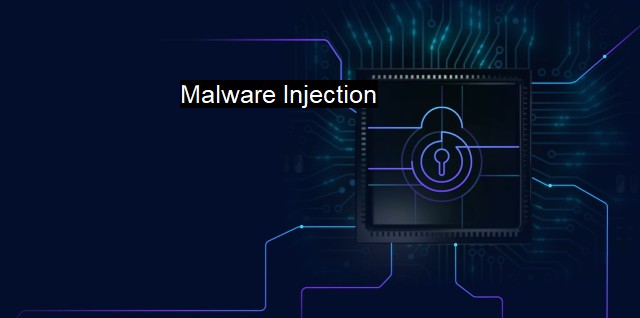What is Malware Injection?
Malware Injection: A Devious Cyber-Attack Technique Exploiting System Vulnerabilities to Compromise Security
"Malware injection" is a term used alluding to an illicit procedure whereby malicious programming ("malware") is inserted or "injected" into a protected and functioning software system. Meanwhile, malware itself, the antagonist in this narrative, is malicious software designed specifically to damage, disrupt, or gain unsanctioned access to a computer system. Generally, these malwares clandestinely infiltrate the systems and proceed to compromise them by causing instability, pilfering sensitive data, or producing unwanted advertisements.Malware injections, thus, characterize numerous categories of cyber threats, such as infected software systems discoursing with prohibited internet locations, unbidden transmission of sensitive data, upload and enactment of malevolent software. The malware injection technique often is dosed under complicated and innocent-seeming camouflage, tempting the user to encourage the infection’s entrance. malware injection can be likened to a malicious intruder lurking and waiting for an opportune moment to sneak into your party unnoticed, blend in with the crowd, and purposefully cause havoc.
In examining the kinds of malware, viruses, worms, spyware, adware, rootkits, ransomware, and trojans are the most common types. Each type has its propagation methodology and effects on the victim's system. Some tend to attach themselves to documents and multiply across when these documents are shared. Others spy on the user’s online activity, overrun the user-screen with advertisement, or alter system operation in more dangerous ways. Predominantly the purpose behind these types of attacks typically orbits around money.
A popular method of malware injection is through what is known as an SQL (Structured Query Language) Injection Attack. Here, an attacker exploits a system’s vulnerability that allows unauthorized manipulation of its databases through malicious SQL codes. This avenue offers the attacker data information for further malicious activities. Similar attacks include Cross-Site Scripting (XSS), where the attacker inserts malicious codes into websites, which are run by an unsuspecting user's browser, and Operating System (OS) command injection that involves injecting malicious codes that command the OS itself.
Another method of malware injection is known as a drive-by download attack. In this scenario, malware is unknowingly downloaded from an internet site without the visitor’s knowledge or approval. Also, email attachments and downloads are another potential source of malware injection. Users may inadvertently download a malicious program from a seemingly innocuous email or website.
Bearing the possible turmoil that an insidious malware injection might cause, deploying assertive actions to prevent users from succumbing to their prey cannot be negotiated. The use of reputable antivirus software is one of the most effective preservation strategies. What does it do? Antivirus software, by principle, keeps illicit infiltrations at bay by scanning your computer system vigils against malware and promptly acting on detected threats before they can seize the system.
Strong and proactive preventive measures from users are vital. This cabooses avoiding suspicious emails and downloads, staying clear of unknown websites, and ensuring the software used is up to date. Remember, this includes not just your antivirus software but also your operating system and other relevant software. It's also imperative to routinely patch and upgrade these systems, as most malware targets known vulnerabilities that patches correct.
Education and awareness on the danger posed by malware injection can't be emphasized enough either; knowing the enemy's tactics arm us better against perilous incursions that lie in wait.
Malware injection therefore serves as a sobering reminder of the escalating tech-age threats facing us. Navigating these hazards require a blended approach: scanning systems with reputable antivirus software, system updates, user awareness, and cautious online behavior. Constant adaptation to a rapidly changing digital landscape is equally paramount. For in the aggressive pursuit of progress, it's prudent to understand, anticipate and protect against the trailing risks. Hence, being wise about malware injection and taking requisite precautions to combat this inevitable nemesis can not only keep our digital lives safe but also ensure their longevity.

Malware Injection FAQs
What is malware injection?
Malware injection refers to the process wherein an attacker inserts malicious code into a legitimate software or system. This code can execute on the victim's computer and can cause damage or steal sensitive information.How does malware injection occur?
Malware injection can happen through a variety of methods, including exploiting vulnerabilities in software or through social engineering tactics like phishing emails or fake software updates.What are the consequences of malware injection?
The consequences of malware injection can vary depending on the type of malware injected. It can range from slowing down the system, stealing sensitive data, to causing complete system failure. It can also give attackers access to your system to conduct further attacks.How can I protect myself from malware injection?
To protect yourself from malware injection, make sure you keep your operating system and software up to date, use antivirus software, and be cautious of unsolicited emails or suspicious software downloads. It's also important to avoid clicking on links or downloading attachments from unknown sources or websites.| | A | | | B | | | C | | | D | | | E | | | F | | | G | | | H | | | I | | | J | | | K | | | L | | | M | |
| | N | | | O | | | P | | | Q | | | R | | | S | | | T | | | U | | | V | | | W | | | X | | | Y | | | Z | |
| | 1 | | | 2 | | | 3 | | | 4 | | | 7 | | | 8 | | |||||||